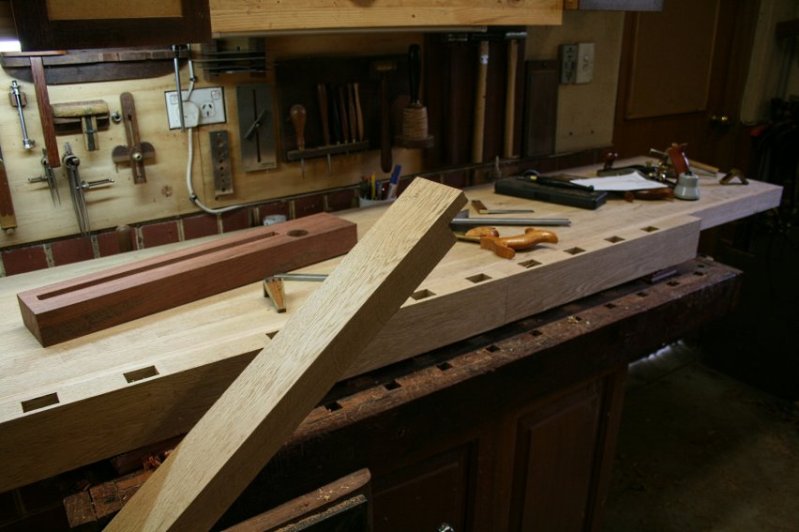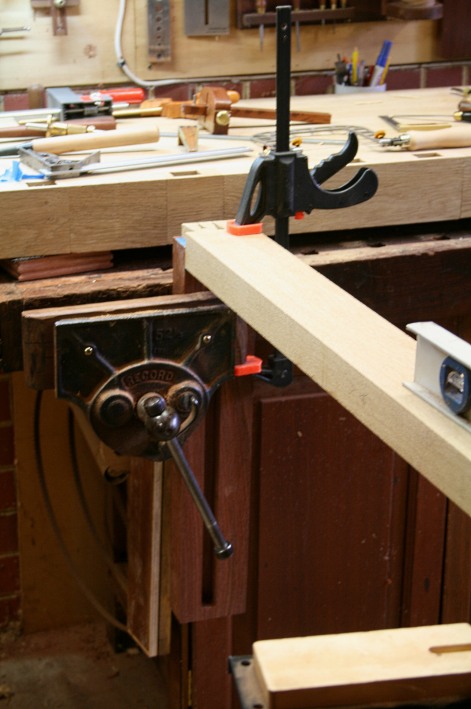 Needs Pictures: 0
Needs Pictures: 0
 Picture(s) thanks: 0
Picture(s) thanks: 0
Results 1 to 15 of 15
Thread: Dovetails on long boards
-
16th September 2022, 01:07 PM #1
 New Member
New Member











- Join Date
- Jul 2022
- Location
- Earth
- Posts
- 3
 Dovetails on long boards
Dovetails on long boards
Greetings from sunny Florida. I'm thinking about putting a mantle-ish thing over our fireplace. I'm thinking 4/4 and 8/4 cherry made into a 67 inch long x 7 inch wide box with dovetails at the corners. How tall, top & bottom details are secondary right now because I can't imagine how I can layout & saw the joints, nor how I can flush the corners.
I'm not bad at dovetails when I can hold the work in a vise and get my old eyes close enough. I'm picturing working from a step ladder with three feet of loose board flapping in the breeze. The thought ain't very appealing.
Any ideas?
Thanks and regards,
Jeff
-
16th September 2022 01:07 PM # ADSGoogle Adsense Advertisement
- Join Date
- Always
- Location
- Advertising world
- Posts
- Many
-
16th September 2022, 02:42 PM #2

Hi Jeff
The longest board I dovetailed was about 7 1/2 feet for my workbench. I wrote this up here: http://www.inthewoodshop.com/ShopMad...ngaBench4.html
It is the Tail board that is the challenging bit.


The tails are offset on the tail board. This is to reduce the depth to join.


Transferring tails to pins was fun!

Regards from Perth
DerekVisit www.inthewoodshop.com for tutorials on constructing handtools, handtool reviews, and my trials and tribulations with furniture builds.
-
16th September 2022, 06:15 PM #3
 SENIOR MEMBER
SENIOR MEMBER











- Join Date
- Nov 2007
- Location
- Victoria
- Posts
- 733

Flat on your bench or saw horses and use a ryoba on your knees. Youíre eyes will be so close to the lines and saw itís dangerous !
You boys like Mexico ?
-
17th September 2022, 10:38 AM #4

If the board is too long to hold vertically in a vise, I lay it on saw-horses. I still use push saws, but if you are a pull-saw person, that should make little difference. Or follow Derek's approach. Funnily enough, I think the longest boards I've dovetailed have been for benches too:
Tool well cons.jpg SG bench 2014.jpg
At least one part of the joint was always on a shorter board that would fit in the vise, so I set out the joints with the more critical cuts (for the pins) on the shorter, more manageable board....
Cheers,IW
-
17th September 2022, 04:59 PM #5

I clamped some long boards vertically on the outside of an upstairs stair landing. It worked, but Derek or Sam's method is probably better.
-
18th September 2022, 01:05 AM #6
 New Member
New Member











- Join Date
- Jul 2022
- Location
- Earth
- Posts
- 3

Thanks for the quick & helpful responses. Graham, using stairs as an elevated work bench is brilliant. Makes me regret I live in a one-story house.
I plan to put tails on the short boards and half-blind sockets on the long boards. As a proper tails-first individual I realize that puts all the difficult fiddly work on the long boards. I can envision Derek's vise method for sawing, and I can chisel/refine the sockets flat on the bench. I like Derek's method for holding the boards to lay out the pins too, though in my case I will have to use the ol' reach-around knife trick. I'll try it on some scraps.
It seems a lot more feasible, thanks to your ideas.
Regards,
Jeff
-
19th September 2022, 12:09 PM #7
 Novice
Novice











- Join Date
- Apr 2020
- Location
- Melbourne
- Age
- 33
- Posts
- 14

Hi Jeff,
I'm currently working through the same issue as you for a long entertainment console unit using panels that are 1800mm wide and 450mm deep. So that's approx 71" x 18".
The corners are all beveled dovetails, with the tails on the longer panels.
I have been using a western-style push saw and have found that placing the panel on my workbench, having the end overhanging and then getting up on-top of the bench and kneeling on the panel has worked best for me.
This has given me the best results in terms of saw control and feel.
I tried cutting a set from "underneath", sitting on a stool at the end of the bench and pushing the saw towards the ceiling but I really struggled with the angle and the saw kept jumping out of the cut.
So if the vise doesn't work out, then this might help.
Best of luck with it!
-
19th September 2022, 01:07 PM #8

My longest was 2.7 m (just under 9 feet).
I did much like Derek, angled in the vice and kneeling on a stool to get the right angle for the cut. I cheated a little though and used a router to clean out the waste. Documented with additional detail at The boat which hangs on our wall – Lance's Workbench (conryclan.com).
20210604_151420-scaled.jpg 20210604_151344-scaled.jpg 20210604_161212-1024x768.jpg
-
19th September 2022, 07:22 PM #9

DDLC, may I respectfully suggest you put a couple of saw-horses on your "to do" list? Balancing on a bench top is probably ok for a younger person (I'll admit to having done it occasionally in the past), but saw-horses are far more convenient & safer at my age, & possibly any age....

Cheers,
IanIW
-
19th September 2022, 10:41 PM #10
 Novice
Novice











- Join Date
- Apr 2020
- Location
- Melbourne
- Age
- 33
- Posts
- 14

Ian,
y’know what i did? I had forgotten all about the cheapie bunnings saw horses hiding away behind a stack of timber. Thanks for reminding me!
I’ll be cracking them out for last two corners!
Cheers,
Dave
-
20th September 2022, 08:37 AM #11

 It's understandable Dave, they are accessories most need only occasionally in the age of tablesaws, but essential for us old Luddites who still regularly employ the old potato-powered type.
It's understandable Dave, they are accessories most need only occasionally in the age of tablesaws, but essential for us old Luddites who still regularly employ the old potato-powered type.
As a kid, I watched my father whip up a pair of traditional horses, and that was the type I always made & used until relatively recently. A few years ago I saw a design in a U.S. mag or website for some really solid horses that are more like low benches.
saw horses.jpg
The advantage of these is the large top & having one pair of legs vertical, allowing short pieces to be sawn/ripped over the 'vertical' side. You can also put holes in the thick top for holdfasts if required. They work really well as conventional horses:
saw horses2.jpg
Their drawback is they are bulky & heavy & occupy a goodly patch of valuable real estate in a small shed (but they are hard to hide & forget! )
)
Cheers,
IanIW
-
20th September 2022, 10:26 PM #12
 Senior Member
Senior Member











- Join Date
- Jul 2008
- Location
- geelong
- Posts
- 359
 inch things
inch things
You reminded me of past things from Fine Woodworking which took me a while to work out and as far as I know was never used in ANY other country that used Imperial measurements. This is the strange 4/4 , 8/4, 6/4 Which apparently means one inch , two inch, Inch and a 1/2. etc. I always found it a bizarre measurement system.
Oh get a comfy mat and down on the knees is certainly easier than trying to get on the top of long vertical things.
-
20th September 2022, 11:03 PM #13
 SENIOR MEMBER
SENIOR MEMBER











- Join Date
- Dec 2012
- Location
- Australia
- Posts
- 684

Skip to the 4 minute mark. ISHITANI - Making a Cupboard with Glass Sliding Doors - YouTube
-
21st September 2022, 09:08 AM #14

This has come up several times over the last 20 years. The same terminology is used in Canada, and it confused me no end when I first encountered it, but once you drop onto it, it's just another way of expressing measurements, based on 1/4 of an inch. The explanation I read somewhere was that the log carriages in sawmills were built to move over in 1/4" increments, so after each pass you moved the carriage over by x quarters to saw the next pass. Rough lumber is always sold as x-quarters, after which the board width may be specified or may not, in which case you expect random widths.
In the good old days when things were not as good as we remember, we also had the "super-foot" ("board-foot" in Nth. America). "Super" is an abbreviation of 'superficial' & was a very useful expression of volume (1/12 of a cubic foot). Given that most wood was sawn to an inch or simple fractions thereof, it was often easy to estimate the number of super feet in a stack of boards with a good degree of accuracy without recourse to tape measures or calculators. I've never figured out a simple way to do that using metric units - a cubic metre just doesn't gel in my mind to any size of stack of typical boards....

Cheers,IW
-
5th October 2022, 05:05 AM #15
 New Member
New Member











- Join Date
- Jul 2022
- Location
- Earth
- Posts
- 3

Thanks for all the additional ideas. I haven't had time to try anything yet -- been plenty distracted since August. Maybe when things quiet down a little....
Similar Threads
-
Dovetailing long boards
By javali in forum WOODWORK - GENERALReplies: 19Last Post: 22nd February 2022, 07:45 AM -
Dovetails and Mitres on Long Boards
By Luke Maddux in forum FURNITURE, JOINERY, CABINETMAKING - formerly BIG STUFFReplies: 4Last Post: 24th March 2017, 09:19 AM -
joining two long boards
By gdf26562 in forum WOODWORK - GENERALReplies: 9Last Post: 27th March 2015, 03:28 PM -
CS Guide - cutting long boards
By niki in forum HOMEMADE TOOLS AND JIGS ETC.Replies: 7Last Post: 20th November 2007, 04:31 PM -
Ripping (resawing) long boards
By bitingmidge in forum BANDSAWSReplies: 23Last Post: 11th December 2005, 03:03 PM



 Thanks:
Thanks:  Likes:
Likes: 
 Reply With Quote
Reply With Quote
